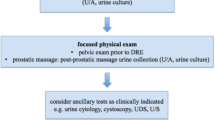Abstract
The urologic chronic pelvic pain syndromes—interstitial cystitis/bladder pain syndrome and chronic prostatitis/chronic pelvic pain syndrome—continue to be both a major cause of morbidity in patients and huge challenge to clinicians. This is largely because patients with common symptoms but differing underlying pain mechanisms are grouped together. In addition, frustration with poor outcomes leads to cynicism and negativism producing an important nocebo effect, further compromising patient care. A new approach is needed. Utilizing principles borrowed from our oncologic colleagues to UCPPS patients can improve all aspects of care:
-
Diagnosis of clinically relevant phenotypes
-
Objectively staging the severity of disease
-
Using sound treatment principles to achieve remission
-
Careful follow-up using objective and subjective measures to fully understand response to therapy
When these principles are applied methodically, clinical success becomes common. When success becomes common, the concepts of complete remission and cure can be introduced.
Similar content being viewed by others
References
Papers of particular interest, published recently, have been highlighted as: • Of importance •• Of major importance
Petersen GL, Finnerup NB, Colluca L, et al. The magnitude of nocebo effects in pain: a meta-analysis. Pain. 2014;155:1426–34.
Schmid J, Theyshon N, Benson S, et al. Neural mechanisms mediating positive and negative treatment expectations in visceral pain: a functional magnetic resonance imaging study on placebo and nocebo effects in healthy volunteers. Pain. 2013;154(11):2372–80. A small, provocative study suggesting central mechanisms for nocebo/placebo effects.
Bingel U. Avoiding nocebo effects to optimize treatment outcomes. JAMA. 2014;312(7):693–4. A good, brief overview of the importance of nocebo and concrete suggestions for minimizing these effects.
Leiby B, Landis J, Propert K, Tomaszewski J, Group. ICDBS. Discovery of morphological subgroups that correlate with severity of symptoms in interstitial cystitis: a proposed biopsy classification system. J Urol. 2007;177(1):142–8. This meticulous histopathologic study clearly demonstrates that detectable bladder abnormalities are only found in the small subgroup of patients with ulcerative disease.
Schaeffer AJ, Knauss JS, Landis R. Leukocyte and bacterial counts do not correlate with severity of symptoms in men with chronic prostatitis: the National Institutes of Health Chronic Prostatitis Cohort Study. J Urol. 2002;168:1048–53.
Nickel JC, Alexander RB, Schaeffer AJ. Leukocytes and bacteria in men with chronic prostatitis/chronic pelvic pain syndrome compared to asymptomatic controls. J Urol. 2003;170:818–22.
Potts JM, Payne CK. Urologic chronic pelvic pain. Pain. 2012;153:755–8.
Held PJ, Hanno PM. Epidemiology of interstitial cystitis: 2. In: Hanno PM, Staskin DR, Krane RJ, Wein AJ, editors. Interstitial cystitis. London: Springer; 1990. p. 29–48.
Fall M and Peeker R: Classic interstitial cystitis—unrelated to bladder pain syndrome. Current Bladder Dysf Rep, 2014
Potts JM: Male pelvic pain syndrome: escaping the snare of prostatocentric thinking. Current Bladder Dysf Rep, 2014
Shoskes DA, Nickel JC, Rackley RR, Pontari MA. Clinical phenotyping in chronic prostatitis/chronic pelvic pain syndrome and interstitial cystitis: a management strategy for urologic chronic pelvic pain syndromes. Prostate Cancer Prostate Dis. 2009;12(2):177–83. The first description of the UPOINT system.
Nickel JC, Shoskes DA, Irvine-Bird K. Clinical phenotyping of women with interstitial cystitis/painful bladder syndrome: a key to classification and potentially improved management. J Urol. 2009;182:155–60.
Shoskes DA, Nickel JC, Dolinga R, Prots D. Clinical phenotyping of patients with chronic prostatitis/chronic pelvic pain syndrome and correlation with symptom severity. Urology. 2009;73:538–42.
Shoskes DA, Nickel JC, Kattan MW. Phenotypically directed multimodal therapy for chronic prostatitis/chronic pelvic pain syndrome: a prospective study using UPOINT. Urology. 2010;75:1249–53. A cohort study demonstrating how the UPOINT system can be used in clinical practice.
Hanno PM, Burks DA, Clemens JQ, et al. AUA Guideline for the diagnosis and treatment of interstitial cystitis/bladder pain syndrome. J Urol. 2011;185:2162–70. The treatment algorithm has been fairly well publicized but the treatment principles are at least as useful.
Nickel JC, Downey J, Ardern D, Clark J, Nickel K. Failure of a monotherapy strategy for difficult chronic prostatitis/chronic pelvic pain syndrome. J Urol. 2004;172:551–4.
Chaikin DC, Blaivas JG, Blaivas ST. Behavioral therapy for the treatment of refractory interstitial cystitis. J Urol. 1993;149(6):1445–8.
Compliance with Ethics Guidelines
Conflict of Interest
Christopher Payne reports that he receives personal fees from and serves on the Medical Advisory Board for both Allergan and Astellas. He also declares that his wife is a consultant for New Pelvic Pain Technologies.
Human and Animal Rights and Informed Consent
This article does not contain any studies with human or animal subjects performed by any of the authors.
Author information
Authors and Affiliations
Corresponding author
Additional information
Christopher K. Payne is an Emeritus Professor of Urology in Stanford University.
This article is part of the Topical Collection on Pelvic Pain
Rights and permissions
About this article
Cite this article
Payne, C.K. A New Approach to Urologic Chronic Pelvic Pain Syndromes: Applying Oncologic Principles to “Benign” Conditions. Curr Bladder Dysfunct Rep 10, 81–86 (2015). https://doi.org/10.1007/s11884-014-0272-5
Published:
Issue Date:
DOI: https://doi.org/10.1007/s11884-014-0272-5




